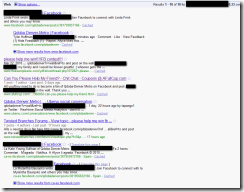It seems that every tech media outlet is frothing at the mouth this morning over Steve Jobs posting an open letter about Flash on the iPhone platforms. I would be remiss if I didn’t share some of my immediate thoughts on what I read.
First off, outside of being a normal Smartphone consumer, I really have no dog in this fight. I’ve written some things in Flash before, but truth be told I try to avoid this platform because of the inherent usability and accessibility issues that surround it. However, Flash has definitely found it’s niche in media: both in video players, as well as an audio player. I currently use Flash music players on Greenfoot’s site, and there still isn’t really an open standards answer out there for music players.
I also do find it funny that Apple and Adobe are feuding, given their extensive history together. I remember when design products like Photoshop were only available on the Mac, and what a big deal it was to have a Windows version. Now, according to Steve Jobs, half of the Creative Suite tools are now on Windows. I seriously believe that if Adobe never bought Macromedia in 2005, these companies would still be BFF’s.
Also if you know me, you know that I do have a disposition towards Apple – I cannot deny that. My difficulty with Apple is that they employ many monopolistic practices and actions, yet somehow get the tech media to view them through some rose-colored glasses. They definitely know how to work the hype machine, and as someone who generally doesn’t like overzealous hype, it really bothers me. However, I think it’s important to tell you where I sit before I talk about where I stand.
Reading through the letter, there are a few things that stand out to me:
First, there’s “Open”.
Oh this is great, we’re going to get a lecture on Adobe’s proprietary from Apple, a company that wont’ let you install their OS on any device they don’t personally manufacture, while also employing a completely locked-down mobile platform where they are the sole gate keepers to what is allowed on that phone. Thanks pot, but I know the kettle is black.
Apple has many proprietary products too. Though the operating system for the iPhone, iPod and iPad is proprietary, we strongly believe that all standards pertaining to the web should be open. Rather than use Flash, Apple has adopted HTML5, CSS and JavaScript – all open standards
Great, we’re glad you’re adopting HTML5, but at the heart of the matter is the fact that HTML5 still isn’t widely adopted on most browsers. Firefox doesn’t currently support most aspects of it, while Internet Explorer has little support for it. Whether or not the two major browsers should now be supporting it is debatable, but the fact is that the majority of the web still doesn’t have access to HTML5. Apple is very forward-thinking, but you need to come back to the present on this.
WebKit has been widely adopted. Google uses it for Android’s browser, Palm uses it, Nokia uses it, and RIM (Blackberry) has announced they will use it too. Almost every smartphone web browser other than Microsoft’s uses WebKit. By making its WebKit technology open, Apple has set the standard for mobile web browsers.
That’s great, but there’s a difference between the mobile web and the mainstream web, and the majority of the Internet still consumes the mainstream web through desktop browsers.
Adobe has repeatedly said that Apple mobile devices cannot access “the full web” because 75% of video on the web is in Flash. What they don’t say is that almost all this video is also available in a more modern format, H.264, and viewable on iPhones, iPods and iPads. YouTube, with an estimated 40% of the web’s video, shines in an app bundled on all Apple mobile devices, with the iPad offering perhaps the best YouTube discovery and viewing experience ever. Add to this video from Vimeo, Netflix, Facebook, ABC, CBS, CNN, MSNBC, Fox News, ESPN, NPR, Time, The New York Times, The Wall Street Journal, Sports Illustrated, People, National Geographic, and many, many others. iPhone, iPod and iPad users aren’t missing much video.
This is a little ingenuous. He’s right, much of the video is encoded in H.264, but much of today’s availability of H.264 is due to Apple strong-arming content providers into making this available. iPhones are hot right now, and everyone wants their content to be made available for Mobile Devices. Apple’s resistance to Flash has forced YouTube and other providers to go through this route. I took felt the above statement conveniently forgot this pandering, and is taking a “what a coincidence!” approach.
However, we’re talking video here. What about audio? Aside from using some of the major streaming services, people who visit bands web sites typically haven no way to consume audio streaming from web sites. There may be some standards conforming to video, but audio streaming still has a ways to go.
Another Adobe claim is that Apple devices cannot play Flash games. This is true. Fortunately, there are over 50,000 games and entertainment titles on the App Store, and many of them are free. There are more games and entertainment titles available for iPhone, iPod and iPad than for any other platform in the world.
I love this, he completely sidestepped the issue and cast his reality-distortion-field so that you feel comfortable in their Walled Garden. I have some fun games on my Droid, but you’re conceding that rather than have a ubiquitous game across multiple platforms, the answer is to splinter the game developer community.
Symantec recently highlighted Flash for having one of the worst security records in 2009. We also know first hand that Flash is the number one reason Macs crash. We have been working with Adobe to fix these problems, but they have persisted for several years now. We don’t want to reduce the reliability and security of our iPhones, iPods and iPads by adding Flash.
That may be true for Macs, but for Windows platforms Flash has been pretty stable. The instability of Flash in Macs is because Apple has held tight reins in who can access their video hardware acceleration. Apple is dragging it’s feet on Adobe’s coattails, then has the gall to complain about performance. I would surmise that Adobe’s problem with Flash on Macs is really Apple’s problem.
Adobe publicly said that Flash would ship on a smartphone in early 2009, then the second half of 2009, then the first half of 2010, and now they say the second half of 2010. We think it will eventually ship, but we’re glad we didn’t hold our breath. Who knows how it will perform?
Adobe definitely has been slow on their mobile strategy, it’s true, but Apple is hardly an innocent bystander in all of this.
Fourth, there’s battery life.
If Apple wasn’t so arrogant in their hardware by not allowing removable/spare batteries, this wouldn’t be an issue. At this point people have accepted the trade off, understanding that if they’re going to have a snazzy phone, they’re going to need to recharge it at least once per day. I ware down the battery on my Droid all the time, but I also have a spare battery for those days that I can’t easily recharge it. Apple has created their own problem by not allowing removable batteries in their devices.
Apple’s revolutionary multi-touch interface doesn’t use a mouse, and there is no concept of a rollover. Most Flash websites will need to be rewritten to support touch-based devices. If developers need to rewrite their Flash websites, why not use modern technologies like HTML5, CSS and JavaScript? Even if iPhones, iPods and iPads ran Flash, it would not solve the problem that most Flash websites need to be rewritten to support touch-based devices.
As a developer, I can tell you that it’s easier to enhance something you’ve already written than completely re-write it on another platform. Also the “modern technologies” point is moot because (like it or not) the reality is that the majority of the web can’t use HTML5. These are not “modern technologies”, they’re bleeding edge, and for many the risk still outweighs the reward.
Sixth, the most important reason. This becomes even worse if the third party is supplying a cross platform development tool. The third party may not adopt enhancements from one platform unless they are available on all of their supported platforms. Hence developers only have access to the lowest common denominator set of features. Again, we cannot accept an outcome where developers are blocked from using our innovations and enhancements because they are not available on our competitor’s platforms.
Wait, a few paragraphs up weren’t you telling me that I should port my Flash app to HTML5? You’re advocating HTML5, which isn’t conforming to the lowest common denominator. Plus, I’m not really sure why you see Adobe as a competitor in this, aren’t they a consumer and a partner of your technologies? This is the problem when you blur the line between owning the platform, and being the sole gatekeepers into the platform. There is where comparisons to a certain board game involving Boardwalks come into play.
Our motivation is simple – we want to provide the most advanced and innovative platform to our developers, and we want them to stand directly on the shoulders of this platform and create the best apps the world has ever seen. We want to continually enhance the platform so developers can create even more amazing, powerful, fun and useful applications. Everyone wins – we sell more devices because we have the best apps, developers reach a wider and wider audience and customer base, and users are continually delighted by the best and broadest selection of apps on any platform.
I don’t understand how these goals can’t be accomplished without bashing Adobe. If people want to have the best experience, then yes, use your native tools. If an App sucks because it’s a crappy port, it’s the App’s fault. I think you need to give the intelligence of your customers a little credit here. If an App sucks on my Droid, I delete it and avoid that App, I don’t chuck my phone out the window.
Flash was created during the PC era – for PCs and mice. Flash is a successful business for Adobe, and we can understand why they want to push it beyond PCs. But the mobile era is about low power devices, touch interfaces and open web standards – all areas where Flash falls short.
So rather than let Adobe evolve their technology into the next platform, you’re just going to cut them off at the knees and dictate their business for them through your strong-arm tactics. Very competitive.
This is definitely a complicated issue, and I in no way am I an Adobe apologist, but this isn’t as black & white as Steve Jobs would like you to believe.



